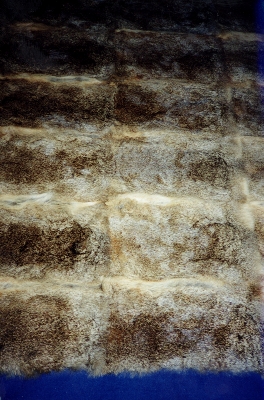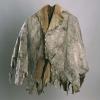Quilt No.614PWH - The Pioneer Women's Hut

Details about the making of this skin rug are unknown but it is almost certainly wattle bark tanned. It was made pre 1912 and belonged to the Hill family who came from 'Buttabone' station in the Warren district of NSW. Mr. And Mrs. Hill came to Sydney to live in 1912 first in MacLeay street and then at Rose Bay. Mrs. Hill died in 1965 aged 100. The rug was stored iin a calico bag in the attic at Rose Bay and was untouched until 1998 when a Hill descendant inherited the house and found it in the attic. It is thought it was never used. It was donated to The Pioneer Women's Hut through Deirdre O'Donnell, previously Deirdre Hill. It is displayed occasionally at the museum.
" Among the various properties offered at auction on the 14th February, 1870, by Richardson and Wrench on behalf of the Christie and Wentworth partnership were Merangbone and Buttabone, consisting of about 108.000 acrea in six adjoining blocks with 3.000 cattle and 4.000 wether sheep. G.Hill Jnr., the buyer paid 4 pound ten a head for the cattle and 6/- each for the sheep. The total price was about 15 thousand pounds�����..Eventually, Buttabone was the largest freehold property on the Macquarie. The present large woolshed was built about 1890 to accommodate sixty two machine shearers���.
In 1924 the Hill family severed their connection with the Warren district when 1108.000acres of Buttabone was sold at auction in subdivision."
[Ref: "Across the Black Soil Plains - a History of the Warren District" by R.M.Brennan]






